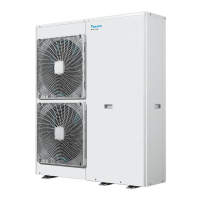Troubleshooting by Indication on the Remote Controller ESIE09-08A
220 Troubleshooting
[CHECK 2] Check for causes of drop in low pressure
Referring to the Fault Tree Analysis (FTA) shown below, probe the faulty points.
Abnormally low
low-pressure
(Low evaporating
temperature)
[Heating]
(See *1.)
Faulty outdoor
unit electronic
expansion valve
Faulty valve coil
Faulty valve body
←
Are the coil resistance and insulation normal?
[In heating]
If the outdoor unit
electronic
expansion valve
excessively
throttled:
(See *2.)
Faulty
control
Faulty low pressure sensor
Faulty suction pipe thermistor
Faulty control PCB
←
Are the electrical characteristics normal?
←
Check for the thermistor resistance and
connection.
Low suction air
temperature of
the evaporator
[In heating]
Low suction air temperature of outdoor unit
←
Is the outdoor temperature not less than -15°C
Faulty outdoor temperature thermistor of outdoor unit
←
Is the connector properly connected?
Are the thermistor resistance characteristics normal?
High pipe
resistance
Abnormal piping length
Bent or crashed pipe
Clogging of foreign particles
Stop valve closed
←
Does the piping length fall in the permissible range?
←
Conduct visual checks for pipe conditions.
←
Is there any temperature difference caused before and
after the filter or branch pipe?
¬
Check to be sure the stop valve is open.
Less
circulation
quantity of
refrigerant
Degradation in
condensing
capacity
Inadequate refrigerant quantity
←Refer to P.189.
Moisture choke
←Eliminate moisture by vacuum operation.
Dirty
evaporator
Decreased
fan airflow
rate
Decreased
fan output
Faulty fan motor
←
Can the fan motor be rotated with hands?
Are the motor coil resistance and insulation normal?
←Is the heat exchanger clogged?
Faulty control PC board
(Including capacity setting)
←
If a spare PC board is mounted, is the capacity
setting properly made?
High air
passage
resistance
Dirty filter
←
Is there any obstacle in the air passage?
←Is the air filter clogged?
Obstacle
*1: The “low pressure protection control” includes low pressure protection control and hot gas bypass control. For details, refer to P.61.
*2: In heating, the outdoor unit
electronic expansion
valve (EV1) is used for “superheated degree control of outdoor unit heat exchanger”.
(For details, refer to P.51.)
Faulty electronic
expansion valve
control
C: SDK04009

